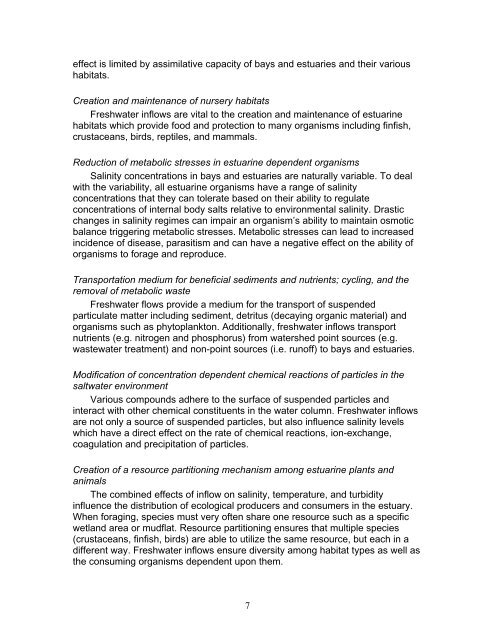The Economic Value of Water and Ecosystem Preservation
The Economic Value of Water and Ecosystem Preservation
The Economic Value of Water and Ecosystem Preservation
Create successful ePaper yourself
Turn your PDF publications into a flip-book with our unique Google optimized e-Paper software.
effect is limited by assimilative capacity <strong>of</strong> bays <strong>and</strong> estuaries <strong>and</strong> their various<br />
habitats.<br />
Creation <strong>and</strong> maintenance <strong>of</strong> nursery habitats<br />
Freshwater inflows are vital to the creation <strong>and</strong> maintenance <strong>of</strong> estuarine<br />
habitats which provide food <strong>and</strong> protection to many organisms including finfish,<br />
crustaceans, birds, reptiles, <strong>and</strong> mammals.<br />
Reduction <strong>of</strong> metabolic stresses in estuarine dependent organisms<br />
Salinity concentrations in bays <strong>and</strong> estuaries are naturally variable. To deal<br />
with the variability, all estuarine organisms have a range <strong>of</strong> salinity<br />
concentrations that they can tolerate based on their ability to regulate<br />
concentrations <strong>of</strong> internal body salts relative to environmental salinity. Drastic<br />
changes in salinity regimes can impair an organism’s ability to maintain osmotic<br />
balance triggering metabolic stresses. Metabolic stresses can lead to increased<br />
incidence <strong>of</strong> disease, parasitism <strong>and</strong> can have a negative effect on the ability <strong>of</strong><br />
organisms to forage <strong>and</strong> reproduce.<br />
Transportation medium for beneficial sediments <strong>and</strong> nutrients; cycling, <strong>and</strong> the<br />
removal <strong>of</strong> metabolic waste<br />
Freshwater flows provide a medium for the transport <strong>of</strong> suspended<br />
particulate matter including sediment, detritus (decaying organic material) <strong>and</strong><br />
organisms such as phytoplankton. Additionally, freshwater inflows transport<br />
nutrients (e.g. nitrogen <strong>and</strong> phosphorus) from watershed point sources (e.g.<br />
wastewater treatment) <strong>and</strong> non-point sources (i.e. run<strong>of</strong>f) to bays <strong>and</strong> estuaries.<br />
Modification <strong>of</strong> concentration dependent chemical reactions <strong>of</strong> particles in the<br />
saltwater environment<br />
Various compounds adhere to the surface <strong>of</strong> suspended particles <strong>and</strong><br />
interact with other chemical constituents in the water column. Freshwater inflows<br />
are not only a source <strong>of</strong> suspended particles, but also influence salinity levels<br />
which have a direct effect on the rate <strong>of</strong> chemical reactions, ion-exchange,<br />
coagulation <strong>and</strong> precipitation <strong>of</strong> particles.<br />
Creation <strong>of</strong> a resource partitioning mechanism among estuarine plants <strong>and</strong><br />
animals<br />
<strong>The</strong> combined effects <strong>of</strong> inflow on salinity, temperature, <strong>and</strong> turbidity<br />
influence the distribution <strong>of</strong> ecological producers <strong>and</strong> consumers in the estuary.<br />
When foraging, species must very <strong>of</strong>ten share one resource such as a specific<br />
wetl<strong>and</strong> area or mudflat. Resource partitioning ensures that multiple species<br />
(crustaceans, finfish, birds) are able to utilize the same resource, but each in a<br />
different way. Freshwater inflows ensure diversity among habitat types as well as<br />
the consuming organisms dependent upon them.<br />
7
















